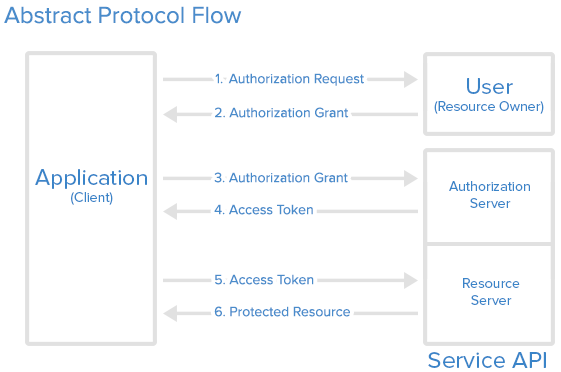WISE-PaaS/Single Sign-On(SSO)
Contents
Introduction
Single Sign-On (SSO) is part of Advantech WISE-PaaS cloud solution and plays an important role in the interoperability of Internet identity. It provides a central login mechanism.
WISE-PaaS/Single Sign-On utilizes Keycloak which is an open source identity and access management for modern applications and services.
API Protocol Flow
The following is a basic standard workflow. It presents the key concept of Singn-On between each other.
- User/Resource owner : Who authorizes others to access Protected Resource. If the role is human, it means the end-user.
- Application/Client/Browser : An application ,client or a browser page represents the Resource Owner to access the Protected Resource.
- Authorize Server : The server issues the Access Token after user are authenticated. (WISE-PaaS/Single Sign-On server)
- Resource Server : The server hosting Protected Resource accept requests according to Access Token.
Here is a more detailed explanation of the steps in the diagram:
- The application requests authorization to access service resources from the user
- If the user authorized the request, the application receives an authorization grant
- The application requests an access token from the authorization server (API) by presenting authentication of its own identity, and the authorization grant
- If the application identity is authenticated and the authorization grant is valid, the authorization server (API) issues an access token to the application. Authorization is complete.
- The application requests the resource from the resource server (API) and presents the access token for authentication
- If the access token is valid, the resource server (API) serves the resource to the application
Another more detailed flow chart:
Features Overview
WISE-PaaS/Single Sign-On(SSO) which base on keycloak has the following features.
- Single-Sign On : Login once to multiple applications
- Standard Protocols : OpenID Connect, OAuth 2.0 and SAML 2.0
- Centralized Management : For admins and users
- Adapters : Secure applications and services easily
- High Performance : Lightweight, fast and scalable
- Clustering : For scalability and availability
- Themes : Customize look and feel
- Extensible : Customize through code
- Password Policies : Customize password policies
Components
WISE-PaaS/Single Sign-On server plays as a public web server and provide client Adapters makes it really easy to secure applications.
- OpenID Connect Server : WISE-PaaS/Single Sign-On server follows standard Protocols include OpenID Connect, OAuth 2.0. and SAML 2.0, please reference server setting documents at document session.
- OpenID Connect Client : WISE-PaaS/Single Sign-On server provides generic OpenID Connect, please reference sample code at document session.
- OAuth 2.0 Server : WISE-PaaS/Single Sign-On server follows standard Protocols include OpenID Connect, OAuth 2.0. . and SAML 2.0, please reference server setting documents at document session.
- OAuth 2.0 Client : WISE-PaaS/Single Sign-On server provides generic OAuth 2.0 Client Connect, please reference sample code at document session.
Implementation
WISE-PaaS provides a complete service for Single Sign-On. There are tree sections for developer to implement.
- 'Settingson 'WISE-PaaS/Single Sign-On server
- Apply a realm administrator account for WISE-PaaS/Single Sign-On server. Please sen a request to WISE-Paas/OpenID Connect service manager by E-mail. And provide the following information
- Service name : [RMM] as your realm.
- Client name : [RMMClient] a client definition for a app to login in.
- User registration : [True/False] Enable/Disable user registeration.
- Administrator account : [RMMAdmin] Use this account to manage this realm. The default password is same as account name. Change password after first login
- Setting your service on WISE-PaaS/Single Sign-On server
- Login WISE-PaaS Single Sign-On server
- Authorization Setting, Only if you want to enable authorization Services.
- Enabled authorization on client setting.
- Create a Resource : Creating the resources that you want to protect.
- Create a Permission : A permission associates the object being protected and the policies that must be evaluated to decide whether access should be granted.
- Create a Role : Use this type of policy to define conditions for your permissions where a set of one or more roles is permitted to access an object.
- Create a User : Craete a login account for SSO with role mapping of client.
- Evaluate : When designing your policies, you can simulate authorization requests to test how your policies are being evaluated with a json format result.
- Get Client App setting
- Realm Public Key : Get the public key from Realms setting-> [Realm]->Keys-> Public key.
- Client Credentials Secret : Get Secret from Clients->Credentials->Secret
- Apply a realm administrator account for WISE-PaaS/Single Sign-On server. Please sen a request to WISE-Paas/OpenID Connect service manager by E-mail. And provide the following information
- Application for end user
- Copy the json , html sample code to your local web site.
- Modify json setting.
- Once the test HTML page is opened, it is automatically directed to OpenID Connect Server.
- While login success, it will automatically lead back to test page.
- Verify Access Token on Resource Server
- Decode JWT access tokens
- Response to client according user protected resources.

